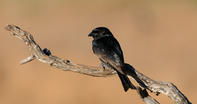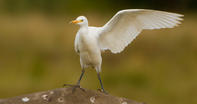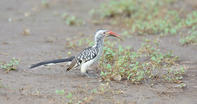Symbiosis refers to a protracted relationship between two species, where one of the species may either benefit from the association, be negatively affected or not affected in any way.
Commensalism

Commensalism is a form of symbiosis. In commensalistic relationships, one of the species gains direct benefit from associating with the other, while the second species derives no benefit, but is not negatively affected in any way. Birds are masters of opportunism and may use other mammalian species particularly, to their advantage.
The fork-tailed drongo is a bold little black bird with a forked tail, as its name suggests, and a reddish eye. It is well known for its ability and tendency to mimic other birds’ calls. The complexity of the tune copied and repeated is one of the criteria for which a female drongo might select a mate. Drongo’s are particularly adept at mimicking the call of the pearl-spotted owlet. Drongo’s are aerial hawkers, snapping insects out of the sky with acrobatic manoeuvres.
In this respect, they use large mammals such as herds of impala or buffalo to their advantage. As the herds move and feed, they disturb and flush out insects in the grass which the drongos catch. They perch around the feeding herbivores in between mouthfuls and wait for more insects to be flushed up. Then with the swiftness of a small fighter aircraft, they dart in behind the mammals’ hooves to snap the insects out of the air. On occasion, if things are not happening quickly enough, drongos may even give a false alarm call setting the feeding animals to flight a short distance and then they quickly monopolize on the sudden flush of insects.
Birds that build their nests in trees are essentially entering a commensalistic relationship with that species of tree. The bird benefits enormously by having a substrate on which to build its nest and is sheltered and protected in the tree. The tree derives no benefit from the bird’s nest being there but neither is it harmed in any way.
Tick Birds

The cattle egret is the well-known foot servant of buffalo, rhino and eland, patiently following these animals through the grassland. Insects disturbed by the movement of the mammal’s hooves through the bush, provide a hearty meal for the egrets. But over an above the feast picked out of the grass, cattle egrets may also land and perch on these large herbivores removing ticks and other ectoparasites much like oxpeckers do. They were originally called ‘tick birds’ for this habit.
Mutualism

Mutualism is another form of symbiosis, but both species benefit directly from their interaction with one another.
Yellow and red-billed hornbills enjoy a mutualistic relationship with the dwarf mongoose. These species can often be found foraging together. Dwarf mongoose live in groups of about 12 individuals, and move through an area together, overturning stones looking for scorpions and other invertebrates. They are astute diggers as well. As the troop of mongoose forage, some of their prey escapes or too much is flushed out for the individual to grab. This is where the hornbill benefits.
Hornbills will quickly snap up whatever the dwarf mongoose miss. In return, the hornbills provide an alarm system, warning the mongoose of danger, that they may not detect, due to being absorbed in feeding. The hornbills even raise the alarm for aerial predators, that are only a threat to the mongoose and not themselves. This relationship is so successful that the hornbills will even wait for dwarf mongoose outside their burrows in the mornings, having followed them home the evening before. If the mongoose are slow to rise, the hornbills will call at the termite mound where the mongoose have bedded down, in an attempt to rouse them. Although both species benefit from their mutual association, this is not an obligatory form of mutualism, as both species can still exist without the other and their shared relationship.
By Megan Emmett